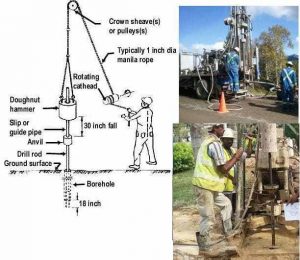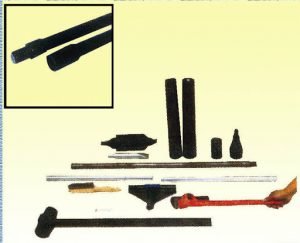Standard penetration test
SPT is a low-cost and simple testing procedure widely used in the geotechnical investigation to determine the relative angle of shearing resistance of cohesionless soils and density and also the strength of stiff cohesive soils.
A standard penetration test is a borehole that has to be drilled to the desired sampling depth.attached to the drill rod of a split-spoon sampler is placed at the testing point. A hammer of 140 lbs(63.5 kg) is dropped repeatedly from a height of 30 inches(76 cm) driving the sampler into the ground until reaching a depth of 6 inches(15 cm).

The number of the required blows is recorded by a notebook. The test procedure is repeated two more times until a total penetration of 18 inches or 45 cm is achieved. the total number of blows required to penetrate the remaining 30 cm depth and The number of blows required to penetrate the first 15 cm is called “seating drive” which is known as the standard penetration resistance or otherwise the N-value. the N-value more then 50 the test is discontinued and is called a “refusal” then repeated.
Concept
The Standard Penetration test (SPT) is commonly used to determine the geotechnical engineering properties of subsurface soils and it is a situ testing method of soil properties. It is an inexpensive and simple test to estimate the relative density of soils and approximate shear strength parameters.
Description and procedure
This involves driving a standard thick-walled sample tube into the ground at the bottom of a hole by blows from a slide hammer with falling standard distance and weight. The sample tube is driven 15 cm into the ground and then the number of blows needed for the tube to penetrate every 6 inches(15 cm) up to a depth of 18 in (45 cm) is recorded. The sum of the total number of blows required for the third and second 6 inches. penetration is reported as the Standard penetration test blow count value, commonly termed “N-value’’ or the “standard penetration resistance”.

Provides The N-value an indication of the relative density of the subsurface soil, and N- value used in empirical geotechnical correlation to estimate the approximate shear strength properties of the soils.
Correlation between Standard penetration test or N value, relative density, and friction angle.
| Standard penetration test N3 [Blows/0.3 m – 1 ft] | Soi packing | Relative Density [%] | Friction angle [°] |
| < 4 | Very loose | < 20 | < 30 |
| 4 -10 | Loose | 20 – 40 | 30 – 35 |
| 10 – 30 | Compact | 40 – 60 | 35 – 40 |
| 30 – 50 | Dense | 60 – 80 | 40 – 45 |
| > 50 | Very Dense | > 80 | > 45 |
Standard Penetration Test Tools.
- Driving head (anvil).
- Guiding rod.
- Tripod.
- Extension rods.
- Drilling Rig.
- Split spoon (tube).
- Drop hammer 65 kg (140 lbs ).

Standard Penetration Test Theory.
The number of blows required for 12 inches penetration resistance of the soil. It is generally referred to as the ‘N’ value and measured in blows penetration.
The Standard penetration test is widely used to get the bearing capacity of soil directly at a certain depth. We find the consistency of clayey soils can often be estimated from this test.
When a hole is extended to a predetermined depth, and the sampler (split spoon) is lowered to the bottom of the borehole, and the drill tools are removed.
By hammer blows to the top of the drill rod, The sampler is driven into the soil. The standard weight of the hammer is 65 kg(140 lbs); the number of blows required for spoon penetration of three intervals 15 cm (6inches) is recorded.
The number of blows required for the last two times is added to give the standard penetration number at that depth of the borehole.
Observations and Calculations:
| Depth ( cm ) | NO. of blows / 15 cm. | N value |
| . | . | . |
for example
The penetration resistance value, N of the soil is __assume 55__blows.
Formula: q= 3.5 (55-3) [B+0.3/2B]Rw2RD.
Where.
q= Allowable net pressure in T/m2
N= Standard penetration number
B= Breadth of footing in meters
Rw2= Water reduction factor= 0.5 [ 1+Z/B]
RD= Depth factor = 1+D/B C or C= 2.0
Z= Depth of foundation level below the water table.
Precautions:
- If the standard penetration test is to be carried out in gravelly soils and then the driving shoe is replaced by a solid 60-degree cone.
- Below the water table, care should be taken to avoid entry of water through the bottom of the borehole due to the loosening of the soil.
- Water should be added as needed to maintain the water table level in the borehole.
- If the test is carried out in very silty sand and fine sand below the water table the measured “N” value if greater then N <15, should be corrected for the increased resistance and excess water pressure set up during being unable and driving to lose immediately.
- Mud drilling can be used to support the sides of the borehole.
- Stop dropping weight and when the sample penetrates less than 25 mm under the 50 blows.
